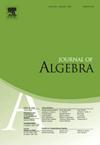The subgroup lattice of polycyclic groups
IF 0.8
2区 数学
Q2 MATHEMATICS
引用次数: 0
Abstract
Let G be a polycyclic-by-finite group, and let X be a subgroup of G. It has been proved by Kegel [Math. Ann. 163 (1966), 248–258] that if the image of X is subnormal in every finite quotient of G, then X is actually subnormal in G; while Robinson [Invent. Math. 10 (1970), 38–43] and Wehrfritz [Proc. London Math. Soc. 20:3 (1970), 101–122] proved that a polycyclic-by-finite group is nilpotent provided that all its finite quotients are nilpotent.
Our first main result (Theorem 2.4) shows that every modular subgroup can be similarly recognized by only looking at the finite quotients of polycyclic-by-finite groups. This extends a theorem of Lennox and Wilson [Arch. Math. (Basel) 28 (1977), 113–116] and improves the main result of Musella [Arch. Math. (Basel) 76 (2001), 161–165] — see also Corollary 2.6.
Our second main result (Theorem 2.16) provides a detailed description of uniquely complemented subgroups in infinite polycyclic-by-finite groups. This is the first non-trivial characterization of this type of subgroups in the infinite case (see [18], p.142), and it has some surprising consequences. It shows in fact that in infinite polycyclic-by-finite groups, the neutral subgroups coincide with the join-distributive subgroups (Corollary 2.31), and that the meet-quasi-distributive subgroups coincide with the uniquely complements subgroups (Theorem 2.22); thus, we face one of those rare occasions in which some types of subgroups coincide in the infinite case but they do not coincide in the finite case. Further relevant consequences of this result deal with detailed descriptions of meet-distributive and join-distributive subgroups (Theorems 2.28 and 2.26), and with the possibility of recognizing all the previously mentioned types of subgroup starting from their images in the finite quotients (Corollary 2.17, Corollary 2.21, Theorem 2.23 and Theorem 2.29).
Finally, in the spirit of Baumslag, Cannonito and Miller III [Math. Z. 153 (1977), 117–134], we also provide theoretical algorithms to determine if a given subgroup of a polycyclic-by-finite group is a modular, join-distributive, meet-(quasi-) distributive, uniquely complemented, and neutral (Corollary 2.9 and Theorem 2.32).
多环群的子群格
设G是一个有限多环群,设X是G的一个子群,这已由Kegel[数学]证明。[Ann. 163(1966), 248-258],如果X的像在G的每一个有限商中都是次正规的,则X在G中实际上是次正规的;而罗宾逊[发明]。数学。10(1970),38-43]和Wehrfritz [Proc.伦敦数学。][Soc. 20:3(1970), 101-122]证明了一个有限多环群是幂零的,只要它的所有有限商都是幂零的。我们的第一个主要结果(定理2.4)表明,每个模子群都可以类似地通过只看多环乘有限群的有限商来识别。这扩展了Lennox和Wilson [Arch]的一个定理。数学。(Basel) 28(1977), 113-116]并改进了Musella [Arch。数学。(巴塞尔)76(2001),161-165]-另见推论2.6。我们的第二个主要结果(定理2.16)提供了无限多环乘有限群中唯一互补子群的详细描述。这是这类子群在无限情况下的第一个非平凡的刻画(见[18],第142页),它有一些令人惊讶的结果。实际上证明了在无限多环有限群中,中性子群与联合分配子群重合(推论2.31),满足拟分配子群与唯一互补子群重合(定理2.22);因此,我们面临着一种罕见的情况,即某些类型的子群在无限情况下重合,而在有限情况下却不重合。该结果的进一步相关结果处理满足分配和连接分配子群的详细描述(定理2.28和2.26),以及从它们在有限商中的图像开始识别所有前面提到的子群类型的可能性(推论2.17,推论2.21,定理2.23和定理2.29)。最后,本着鲍姆斯拉格、加农托和米勒III的精神。Z. 153(1977), 117-134],我们还提供了理论算法来确定多环有限群的给定子群是否为模、连接分布、满足(拟)分布、唯一互补和中立(推论2.9和定理2.32)。
本文章由计算机程序翻译,如有差异,请以英文原文为准。
求助全文
约1分钟内获得全文
求助全文
来源期刊

Journal of Algebra
数学-数学
CiteScore
1.50
自引率
22.20%
发文量
414
审稿时长
2-4 weeks
期刊介绍:
The Journal of Algebra is a leading international journal and publishes papers that demonstrate high quality research results in algebra and related computational aspects. Only the very best and most interesting papers are to be considered for publication in the journal. With this in mind, it is important that the contribution offer a substantial result that will have a lasting effect upon the field. The journal also seeks work that presents innovative techniques that offer promising results for future research.
 求助内容:
求助内容: 应助结果提醒方式:
应助结果提醒方式:


